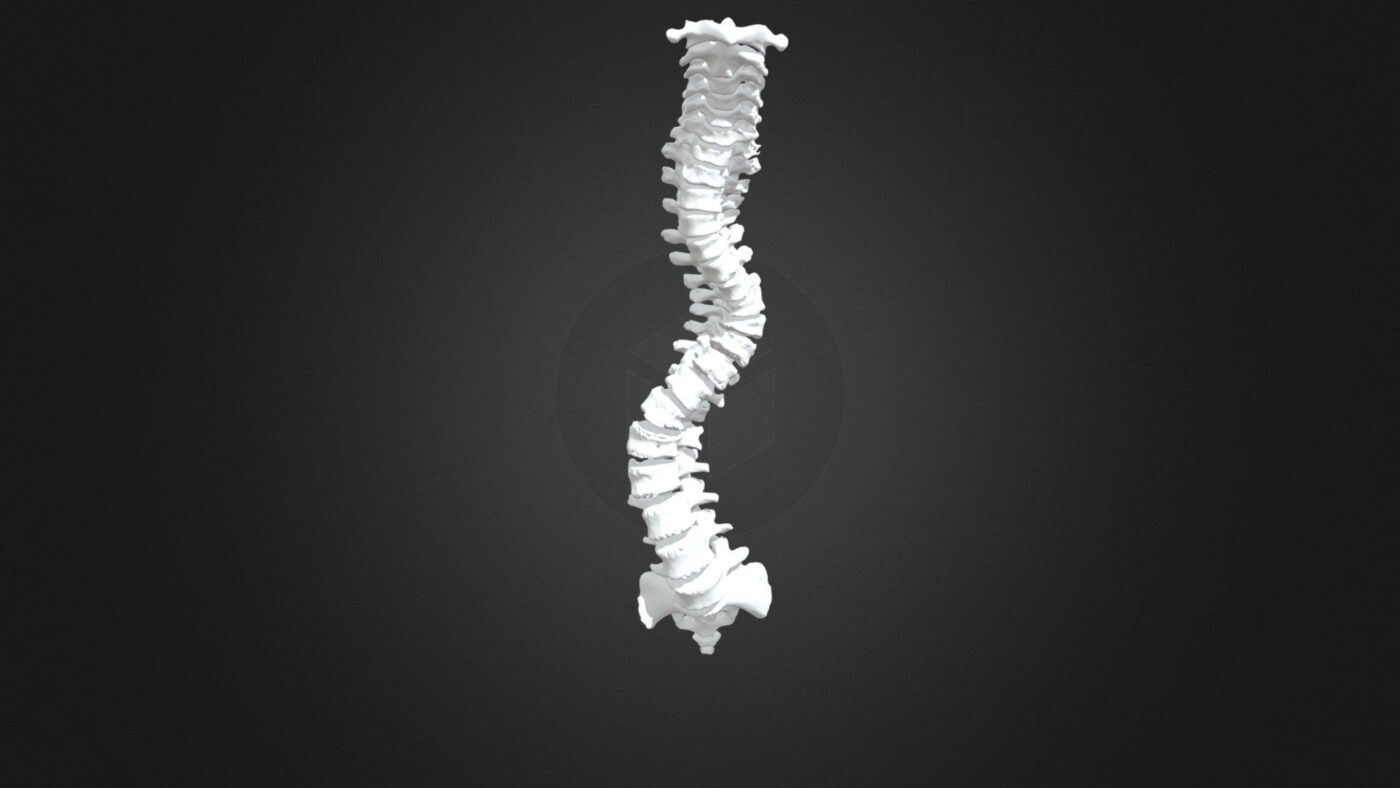A escoliose é uma doença caracterizada por uma curvatura anormal da coluna vertebral. Um tipo específico de escoliose é conhecido como escoliose em forma de S, que afecta a região toracolombar da coluna vertebral. Este artigo tem como objetivo fornecer uma visão global da escoliose em forma de S da coluna toracolombar, incluindo o seu diagnóstico e opções de tratamento.
Introdução ao Escoliose em forma de S da coluna toracolombar
A escoliose em forma de S refere-se a uma curvatura da coluna vertebral que se assemelha à letra "S" quando vista de trás. Afecta normalmente a região toracolombar, que é a área onde a coluna torácica (parte superior das costas) transita para a coluna lombar (parte inferior das costas). Esta doença pode causar dor, desconforto e limitações funcionais significativas nos indivíduos afectados.

Compreender a anatomia da coluna toracolombar
Para compreender melhor a escoliose em forma de S da coluna toracolombar, é essencial ter uma compreensão básica da anatomia desta região. A coluna vertebral toracolombar é constituída por doze vértebras torácicas e cinco vértebras lombares. Estas vértebras estão ligadas por discos intervertebrais, que proporcionam flexibilidade e absorção de choques. A coluna vertebral também abriga a medula espinhal, que transmite sinais nervosos entre o cérebro e o resto do corpo.
Sinais e sintomas de Escoliose em forma de S na região toracolombar Região
Os sinais e sintomas da escoliose em forma de S na região toracolombar podem variar consoante a gravidade da curvatura. Os sintomas mais comuns incluem dores nas costas, rigidez muscular, alinhamento irregular dos ombros ou da anca e assimetria visível da coluna vertebral. Alguns indivíduos podem também ter dificuldade em respirar ou problemas digestivos devido à compressão dos órgãos causada pela curvatura anormal.
Ferramentas e técnicas de diagnóstico para a escoliose em forma de S
Para diagnosticar a escoliose em forma de S na coluna toracolombar, os profissionais de saúde utilizam várias ferramentas e técnicas de diagnóstico. O método de rastreio inicial mais comum é um exame físico, em que o profissional de saúde avalia a postura do doente, a amplitude de movimentos e quaisquer sinais visíveis de curvatura da coluna vertebral. Se houver suspeita de escoliose, são normalmente recomendados outros exames imagiológicos.
Imagens de raios X para o diagnóstico de escoliose em forma de S na coluna toracolombar
As imagens de raios X são o padrão de excelência para o diagnóstico da escoliose, incluindo a escoliose em forma de S na coluna toracolombar. As radiografias fornecem imagens pormenorizadas da coluna vertebral, permitindo aos profissionais de saúde medir o grau de curvatura e identificar quaisquer anomalias associadas. Estas imagens também ajudam a determinar a abordagem de tratamento adequada com base na gravidade da doença.

Outras modalidades de imagiologia para avaliar a escoliose em forma de S
Para além das radiografias, podem ser utilizadas outras modalidades de imagiologia para avaliar a escoliose em forma de S na região toracolombar. A Ressonância Magnética (RM) pode fornecer informações mais pormenorizadas sobre os tecidos moles que rodeiam a coluna vertebral, como a medula espinal e os nervos. A tomografia computorizada (TC) pode ser utilizada para avaliar as estruturas ósseas e detetar quaisquer anomalias que possam exigir intervenção cirúrgica.
Classificação e graduação da escoliose em forma de S na região toracolombar
A escoliose em forma de S na região toracolombar é classificada e graduada com base no ângulo de Cobb, que mede o grau de curvatura. A escoliose ligeira é tipicamente definida como um ângulo de Cobb entre 10 e 25 graus, a escoliose moderada varia entre 25 e 40 graus e a escoliose grave é caracterizada por um ângulo de Cobb superior a 40 graus. Esta classificação ajuda a orientar as decisões de tratamento e a prever a potencial progressão da doença.
Opções de tratamento não cirúrgico para a escoliose em forma de S
As opções de tratamento não cirúrgico são frequentemente a primeira linha de tratamento para a escoliose em forma de S na coluna toracolombar, especialmente para casos ligeiros a moderados. Estas opções de tratamento têm como objetivo aliviar a dor, melhorar a postura e evitar uma maior progressão da curvatura. Podem ser recomendados exercícios de fisioterapia, cuidados quiropráticos e técnicas de controlo da dor, como medicação ou acupunctura.
Técnicas de suporte para gerir a escoliose em forma de S na coluna toracolombar
O aparelho ortodôntico é outra opção de tratamento não cirúrgico habitualmente utilizada para gerir a escoliose em forma de S na coluna toracolombar, particularmente em adolescentes com curvatura moderada. Os aparelhos são concebidos para aplicar forças corretivas à coluna vertebral, ajudando a parar ou a abrandar a progressão da curvatura. O tipo e a duração do aparelho dependem da gravidade da escoliose e do potencial de crescimento do indivíduo.

Intervenções cirúrgicas para a correção da escoliose em forma de S
Nos casos de escoliose grave em forma de S na região toracolombar ou quando os tratamentos não cirúrgicos não proporcionam um alívio adequado, pode ser necessária uma intervenção cirúrgica. O principal objetivo da cirurgia é corrigir a curvatura da coluna vertebral e estabilizar a coluna vertebral. Isto é normalmente conseguido através da fusão da coluna vertebral, em que as vértebras afectadas são fundidas entre si utilizando enxertos ósseos e implantes metálicos.
Cuidados pós-operatórios e reabilitação para doentes com escoliose em forma de S
Depois de serem submetidos a uma cirurgia para a escoliose em forma de S na coluna toracolombar, os doentes necessitam de cuidados pós-operatórios e de reabilitação para garantir uma recuperação óptima. Estes cuidados podem envolver a gestão da dor, a fisioterapia e o aumento gradual dos níveis de atividade sob a orientação de profissionais de saúde. As consultas de acompanhamento regulares e os exames imagiológicos são essenciais para monitorizar o progresso e detetar quaisquer potenciais complicações.
Tratamento a longo prazo e prognóstico da escoliose em forma de S na região toracolombar
A gestão a longo prazo da escoliose em forma de S na região toracolombar centra-se na manutenção do alinhamento da coluna vertebral, na gestão da dor e na prevenção de uma maior progressão da curvatura. A realização de exames regulares com profissionais de saúde, a adesão aos exercícios ou aparelhos prescritos e um estilo de vida saudável podem contribuir para um melhor prognóstico. No entanto, é importante notar que o prognóstico pode variar em função da gravidade da escoliose e de factores individuais.
Em conclusão, a escoliose em forma de S da coluna toracolombar é um tipo específico de curvatura da coluna vertebral que pode causar desconforto significativo e limitações funcionais. O diagnóstico precoce e o tratamento adequado são cruciais para gerir eficazmente esta doença. Através de uma combinação de ferramentas de diagnóstico, intervenções não cirúrgicas e opções cirúrgicas, os profissionais de saúde podem ajudar os indivíduos com escoliose em forma de S a obter um melhor alinhamento da coluna vertebral, aliviar a dor e melhorar a sua qualidade de vida.
Referências
- Weinstein SL, Dolan LA, Cheng JC, et al. "Adolescent idiopathic scoliosis" (Escoliose idiopática do adolescente). Lancet. 2008;371(9623):1527-1537. doi: 10.1016/S0140-6736(08)60658-3. Ligação
- Negrini S, Donzelli S, Aulisa AG, et al. "Diretrizes SOSORT 2016: Tratamento ortopédico e de reabilitação da escoliose idiopática durante o crescimento". Escoliose e doenças da coluna vertebral. 2018;13:3. doi: 10.1186/s13013-018-0175-8. Ligação
- Trobisch P, Suess O, Schwab F. "Escoliose idiopática". Dtsch Arztebl Int. 2010;107(49):875-883. doi: 10.3238/arztebl.2010.0875. Ligação
- Hresko MT. "Prática clínica. Escoliose idiopática em adolescentes". N Engl J Med. 2013;368(9):834-841. doi: 10.1056/NEJMcp1209063. Ligação
- Bettany-Saltikov J, Weiss HR, Chockalingam N, et al. "Intervenções cirúrgicas versus não cirúrgicas em pessoas com escoliose idiopática do adolescente". Base de dados Cochrane Syst Rev. 2015;2015(4). doi: 10.1002/14651858.CD010663.pub2. Ligação
- Administração da Segurança Social. "Prestações de invalidez". Ligação
- Lonstein JE, Carlson JM. "A previsão da progressão da curva na escoliose idiopática não tratada durante o crescimento". J Bone Joint Surg Am. 1984;66(7):1061-1071. doi: 10.2106/00004623-198466070-00008. Ligação
- Kaspiris A, Grivas TB, Weiss HR, Turnbull D. "Escoliose: Revisão do diagnóstico e tratamento". Jornal Internacional de Ortopedia. 2013;37(1):34-42. doi: 10.1038/s41390-020-1047-9. Ligação
- Monticone A, Cazzaniga D, Rocca B, Ferrante S. "Efeitos de um programa de exercício multimodal em pacientes com escoliose idiopática do adolescente: A randomized controlled trial". Escoliose e doenças da coluna vertebral. 2016;11:15. doi: 10.1186/s13013-016-0060-1. Ligação
- Weiss HR, Moradi B, Schreiber S, et al. "Bracing for scoliosis in children and adolescents." Base de dados Cochrane Syst Rev. 2013;2013(4). doi: 10.1002/14651858.CD003368.pub3. Ligação
- Berven SH, Wong R, Grabel L. "Scoliosis: Overview and management". Orthop Clin North Am. 2015;46(2):179-191. doi: 10.1016/j.ocl.2014.12.002. Ligação
- McMaster MJ, Lonstein JE, D'Andrea LP. "O tratamento da escoliose idiopática em adultos". Coluna vertebral. 2004;29(7). doi: 10.1097/01.BRS.0000119056.93030.39. Ligação
- Weinstein SL, Dolan LA. "Escoliose: A comprehensive review". Ortopedia. 2004;27(4):233-240. doi: 10.3928/0147-7447-20040701-03. Ligação
- Hsu LC, Cheng JCY. "Escoliose idiopática do adolescente: Uma atualização". Eur Spine J. 2008;17(5):757-767. doi: 10.1007/s00586-008-0677-3. Ligação
- Schreiber S, Parent EC, Nordin M, et al. "Bracing for idiopathic scoliosis in adolescents: Uma revisão sistemática actualizada". Escoliose e doenças da coluna vertebral. 2019;14:9. doi: 10.1186/s13013-019-0162-7. Ligação

